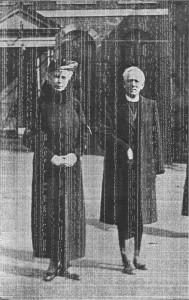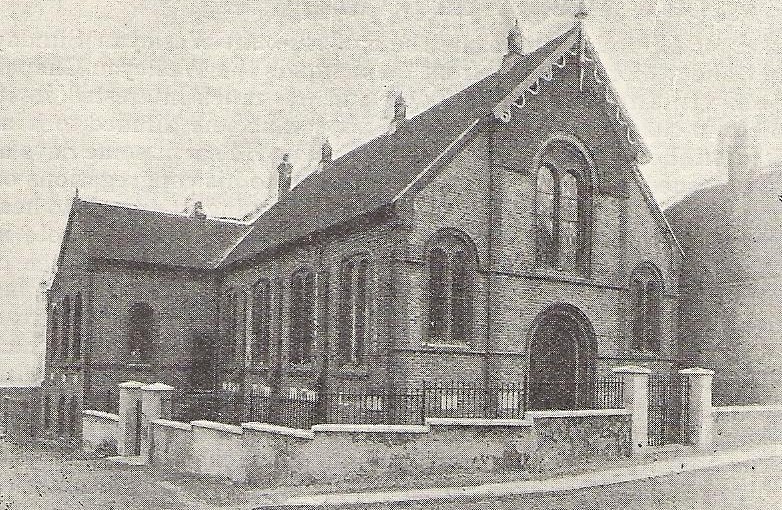The Gungarden Area as I knew it
By Arthur Woodgate
The Methodist Sunday school had not been there for long when I was a lad. It had been all open ground, the chapel opposite in a recess, but a bit older, it was build on what was quite a valuable piece of ground, the soldiers drilling area, where generations of Ryers had been trained as members of the Cinque Port Volunteers and many more official military groupings over the years that followed.
I can imagine them trooping from the castle, forming up on the yard and hearing the officers shouting orders at them, including one to grab their fighting stations, some on the defence wall which are still there and could be used as firearm positions, shooting over the heads of the cannon users. More imagination as to what went on in the years before what I knew as a schoolboy. The ways in and out would have been many, from the Baddings gate end up the step way to the castle. The steps are still there with a pub (Ypres Castle) half way up.
Entry could also be made from the town to the fortified defence area by way of the top end of Baddings Street (now Pump Street) or via Watchbell Street and Church Square from The Strand or Longer Street (now High Street).
Now, as I see it, the old site had been knocked about in one way and another and was now in private ownership, or non-military hands and for some time it belonged to the council with agreement that the army would take it over again in the event of war.
The Westleyans acquired two pieces of the drill yard, and built a chapel on the first around 1900, first one right on the edge of the cliff (my photo shows the front of it behind the Queen and the vicar) why the vicar choose that as a background to welcome Queen Mary instead of his own parish church, I don’t know. The Church Hall (now the church) was constructed in 1924. My mother used to wash stones, bore holes through the middle, put strings through them to make necklaces, and after some decorating sold them on charity stools to raise money and help build this property.
I had to go to church every Sunday, all the Sunday functions were carried out in the one building. Another boy and I used to pump the organ to keep it full of wind from a little room beside the organ, the room had a little window overlooking the Marsh with a lovely view. I attended the building four times each Sunday, including Sunday School, services etc. and various social functions during the week. Every time I had to make my way from home in Winchelsea Road. I used to go round the Strand, Up Trader’s Passage and along Watchbell street. There were two big dogs loose near the Hope Anchor Hotel, still being a small boy, they looked to me like lions and I was frightened of them, so found another route, via Mermaid street and Church Square.
Thinking it over I decided I could not be frightened of dogs all my life so started to cure myself by going past where they were and eventually controlled myself not to run away from them.

Coming in from Pump street there was a the little square on my left with some houses each side. Take a line from Pump street to the Castle and somewhere in front of where the Queen and Vicar are standing in this picture, there were houses each side and two odd ones in the square, one of these was the museum where the Curator lived. He was Mr Charles Price, who was also care taker of the Gungarden, the bottom half of which had a brick wall with double gates which he closed at night and other times of importance, because of the dangerous cliff. no children were allowed in the Gungarden at any time without adults. Mr Price was very strict with us kids and we did not like him. In those days it was unheard of any female to take on a responsible job, so one day, when Charles was refusing us entry to the garden, one of the boys said that his father was Mayor Charles replied,
‘I don’t care if your mother is Mayor, you are not getting in.’
This caused a laugh all over town because no one, at that time, imagined that a woman would ever become Mayor of Rye. In fact, it was to be almost 50 years before the first woman Mayor of Rye (Mrs. Elsie Philpot) was elected to the post
In 1939 the War came along and Hitler’s bombers destroyed the Wesleyan Church. The Church was a grand building, until the bomb. It was pulled down, because it was unsafe. The little square on the left was a little built up area, houses at the side and two along the front, amongst those living in there at that time was Mr Jones the Dentist, he came out alive, as did all the other residents. Mr Jones re-started his business in the High Street, houses were re-built in the little square. The Sunday School was not badly damaged. It had had some extensions, including underground rooms, so it could be converted into the new Methodist Church that we know today. Outside the building looks much the same as I remember it before the war with activities continuing in much the same way but with motors parked outside instead of horses and bikes. It always struck me as funny being next to the “Jolly Sailor” pub and a Police Station.
The Methodist were completely total abstainers, things have been a lot more peaceful since they lost their neighbours!
In the years since World War I have often retraced the steps I took as a schoolboy and because the whole area had been replaced, minus one church building, I felt and still feel, at home. Eric Mason, one of Rye’s great benefactors (he gave the playing fields and the Badger Gate site to the town), lived in one of the new houses next to the Ypres Castle and in the summer months when I walked by he would often call me from a deck chair in his garden. So stopping to say a few words to him it was then just like nothing had happened and the War had not taken place.
“Rye’s Own” May 2013
All articles, photographs and drawings on this web site are World Copyright Protected. No reproduction for publication without prior arrangement.
